stop start SUBARU BRZ 2023 Owner's Manual
[x] Cancel search | Manufacturer: SUBARU, Model Year: 2023, Model line: BRZ, Model: SUBARU BRZ 2023Pages: 432, PDF Size: 16.56 MB
Page 241 of 432
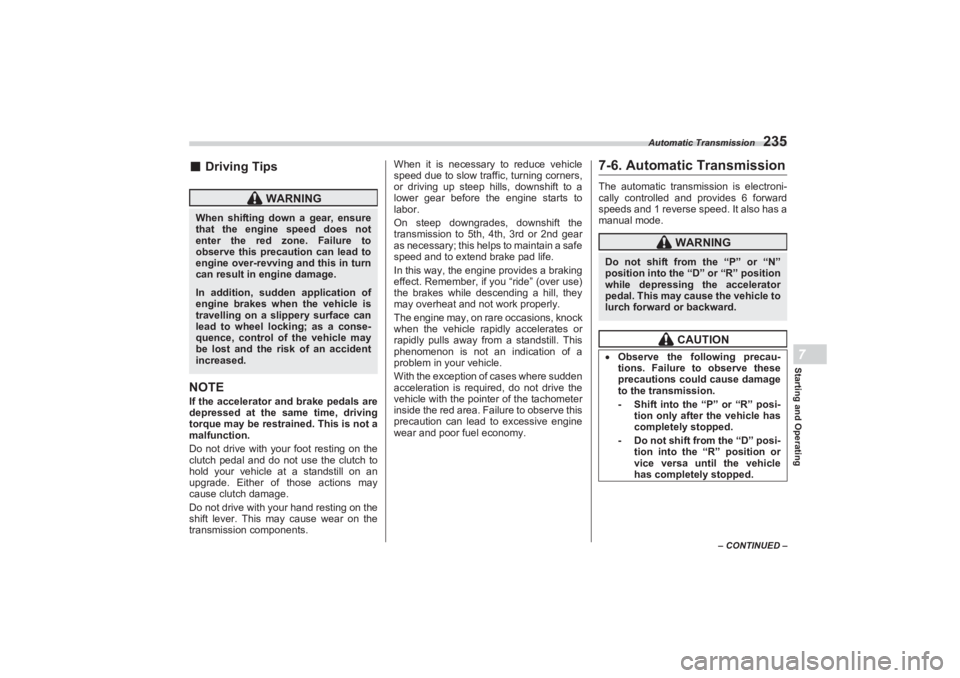
Automatic Transmission
235
Starting and Operating7
– CONTINUED –
■Driving TipsNOTEIf the accelerator and brake pedals are
depressed at the same time, driving
torque may be restrained. This is not a
malfunction.
Do not drive with your foot resting on the
clutch pedal and do not use the clutch to
hold your vehicle at a standstill on an
upgrade. Either of those actions may
cause clutch damage.
Do not drive with your hand resting on the
shift lever. This may cause wear on the
transmission components. When it is necessary to reduce vehicle
speed due to slow traffic, turning corners,
or driving up steep hills, downshift to a
lower gear before the engine starts to
labor.
On steep downgrades, downshift the
transmission to 5th, 4th, 3rd or 2nd gear
as necessary; this helps to maintain a safe
speed and to extend brake pad life.
In this way, the engine provides a braking
effect. Remember, if you “ride” (over use)
the brakes while descending a hill, they
may overheat and not work properly.
The engine may, on rare occasions, knock
when the vehicle rapidly accelerates or
rapidly pulls away from a standstill. This
phenomenon is not an indication of a
problem in your vehicle.
With the exception of cases where sudden
acceleration is required, do not drive the
vehicle with the pointer of the tachometer
inside the red area. Failure to observe this
precaution can lead to excessive engine
wear and poor fuel economy.
7-6. Automatic TransmissionThe automatic transmission is electroni-
cally controlled and provides 6 forward
speeds and 1 reverse speed. It also has a
manual mode.
WARNING
When shifting down a gear, ensure
that the engine speed does not
enter the red zone. Failure to
observe this precaution can lead to
engine over-revving and this in turn
can result in engine damage.In addition, sudden application of
engine brakes when the vehicle is
travelling on a slippery surface can
lead to wheel locking; as a conse-
quence, control of the vehicle may
be lost and the risk of an accident
increased.
WARNING
Do not shift from the “P” or “N”
position into the “D” or “R” position
while depressing the accelerator
pedal. This may cause the vehicle to
lurch forward or backward.
CAUTION
Observe the following precau-
tions. Failure to observe these
precautions could cause damage
to the transmission.
- Shift into the “P” or “R” posi- tion only after the vehicle has
completely stopped.- Do not shift from the “D” posi- tion into the “R” position or
vice versa until the vehicle
has completely stopped.
BRZ_U.book 235 ページ 2022年3月29日 火曜日 午後3時59分
Page 242 of 432

Automatic Transmission
236NOTEWhen the engine coolant tempera-
ture is still low, the transmission will
shift at higher engine speeds than
when the coolant temperature is suffi-
ciently high in order to shorten the
warm-up time and improve driveability.
The gearshift timing will automatically shift to the normal
timing after the
engine has warmed up.
Immediately after transmission fluid
is replaced, you may feel that the trans-
mission operation is somewhat
unusual. This results from invalidation
of data which the on-board computer
has collected and stored in memory to
allow the transmission to shift at the
most appropriate times for the current
condition of your vehicle. Optimized
shifting will be restored as the vehicle
continues to be driven for a while.
Place the shift boot to the original
position after it is lifted. If the shift lever
is operated with the shift boot in the
rolled up position, the shift boot may
have tension and it may disturb the
shift lever operation.
When the vehicle is idling at high
rpm in order to warm up, and the
vehicle is on a slippery road, the trans-
mission may automatically shift to 2nd
gear for stopping and starting off.
■ Select Lever
: Shift with the brake pedal depressed
and push-button ignition switch in the “ON”
position. When shifting between “P” and “D”,
depress the brake pedal and securely stop
the vehicle before shifting.
The select lever has four positions, “P”,
“R”, “N”, “D” and also has a manual gate
for using the manual mode.NOTETo protect the engine while the select
lever is in the “P” or “N” position, the
engine is controlled so that the engine
speed may not become too high even
if the accelerator pedal is depressed
hard.
Do not race the engine for more
than 5 seconds in any position
except the “N” or “P” position
when the brake is applied or when
chocks are used in the wheels.
This may cause the transmission
fluid to overheat. Never move the vehicle rearward
by inertia with the select lever set
in a forward driving position or
move the vehicle forward by
inertia with the select lever set in
the “R” position. Doing so may
result in an unexpected accident
or malfunction. When parking the vehicle, first
securely apply the parking brake
and then place the select lever in
the “P” position. Do not park for a
long time with the select lever in
any other position as doing so
could result in a dead battery.
702768
BRZ_U.book 236 ページ 2022年3月29日 火曜日 午後3時59分
Page 243 of 432
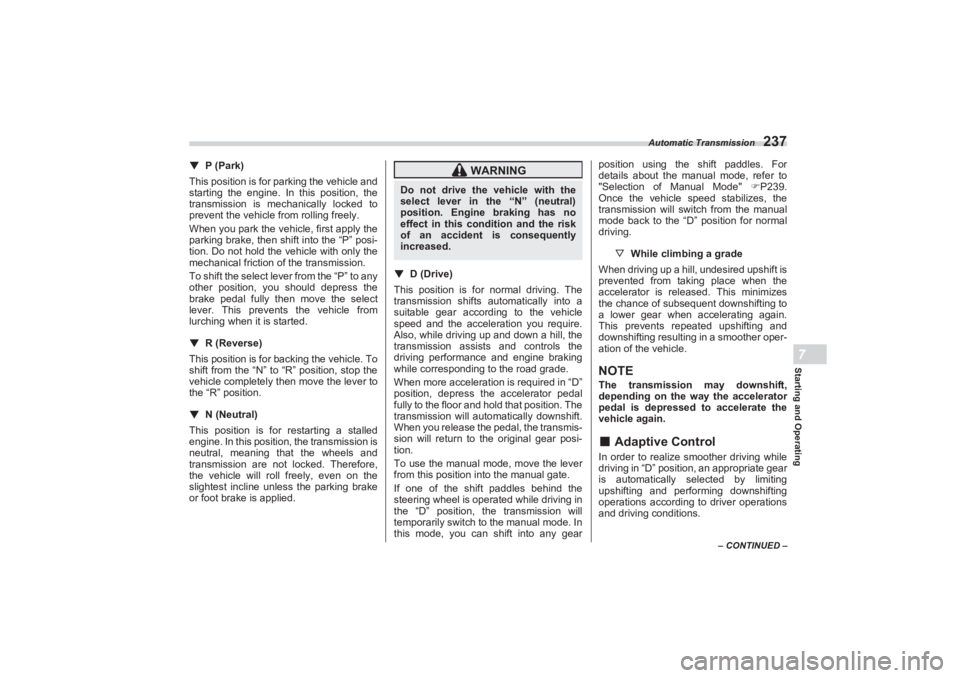
Automatic Transmission
237
Starting and Operating7
– CONTINUED –
▼P (Park)
This position is for parking the vehicle and
starting the engine. In this position, the
transmission is mechanically locked to
prevent the vehicle from rolling freely.
When you park the vehicle, first apply the
parking brake, then shift into the “P” posi-
tion. Do not hold the vehicle with only the
mechanical friction of the transmission.
To shift the select lever from the “P” to any
other position, you should depress the
brake pedal fully then move the select
lever. This prevents the vehicle from
lurching when it is started.
▼ R (Reverse)
This position is for backing the vehicle. To
shift from the “N” to “R” position, stop the
vehicle completely th en move the lever to
the “R” position.
▼ N (Neutral)
This position is for restarting a stalled
engine. In this position, the transmission is
neutral, meaning that the wheels and
transmission are not locked. Therefore,
the vehicle will roll freely, even on the
slightest incline unless the parking brake
or foot brake is applied. ▼
D (Drive)
This position is for normal driving. The
transmission shifts automatically into a
suitable gear according to the vehicle
speed and the acceleration you require.
Also, while driving up and down a hill, the
transmission assists and controls the
driving performance and engine braking
while corresponding to the road grade.
When more acceleration is required in “D”
position, depress the accelerator pedal
fully to the floor and hold that position. The
transmission will auto matically downshift.
When you release the pedal, the transmis-
sion will return to the original gear posi-
tion.
To use the manual mode, move the lever
from this position into the manual gate.
If one of the shift paddles behind the
steering wheel is operated while driving in
the “D” position, the transmission will
temporarily switch to the manual mode. In
this mode, you can shift into any gear position using the shift paddles. For
details about the manual mode, refer to
"Selection of Manual Mode" P239.
Once the vehicle speed stabilizes, the
transmission will switch from the manual
mode back to the “D” position for normal
driving.
▽ While climbing a grade
When driving up a hill, undesired upshift is
prevented from taking place when the
accelerator is releas ed. This minimizes
the chance of subsequent downshifting to
a lower gear when accelerating again.
This prevents repeated upshifting and
downshifting resulting in a smoother oper-
ation of the vehicle.
NOTEThe transmission may downshift,
depending on the way the accelerator
pedal is depressed to accelerate the
vehicle again.■ Adaptive ControlIn order to realize smoother driving while
driving in “D” position, an appropriate gear
is automatically selected by limiting
upshifting and performing downshifting
operations according to driver operations
and driving conditions.
WARNING
Do not drive the vehicle with the
select lever in the “N” (neutral)
position. Engine braking has no
effect in this co ndition and the risk
of an accident is consequently
increased.
BRZ_U.book 237 ページ 2022年3月29日 火曜日 午後3時59分
Page 246 of 432

Automatic Transmission
240the shift paddle twice in rapid succes-
sion.
If the temperature of the transmis-
sion fluid becomes too high, the “AT
OIL TEMP” warning light will illumi-
nate. Immediately stop the vehicle in a
safe place and let the engine idle until
the warning light turns off.▼ Temporary manual mode driving
While driving with the select lever in “D”, if
a shift paddle is operated, the gear can
temporarily be selected. In this case, “M”
and the selected gear number will be
displayed on the combination meter. (If
the engine speed approaches close to the
red zone, an upshift will automatically be
performed.)1) Upshift
2) Downshift
The selected gear, from “M1” to “M6”, will
be displayed on the combination meter.NOTE In the following situations, tempo-
rary manual mode will be cancelled. - When the vehicle speed is low
- When the accelerator pedal is
depressed continuously for a
certain amount of time or more
- When the accelerator pedal is
depressed heavily
- When the select lever is shifted
to a position other than “D”
- When the “+” shift paddle switch
is held down for a period of time
When a downshift is attempted at a
vehicle speed where a downshift is not
possible (when the engine speed
would enter the red zone if a downshift
is performed), the downshift warning
buzzer will sound to inform the driver
that a downshift cannot be performed.■ Driving TipsNOTEIf the accelerator and brake pedals are
depressed at the same time, driving
torque may be restrained. This is not a
malfunction.
On a road surface where there is a risk
of wheelspin (for example, a snow- or gravel covered road), you can start off
from a standstill safely and easily by first
selecting Snow mode.
Always apply the foot or parking brake
when the vehicle is stopped in the “D” or
“R” position.
Make sure to apply the parking brake
when parking your vehicle. Do not hold
the vehicle with only the transmission.
Do not keep the vehicle in a stationary
position on an uphill grade by using the
“D” position. Use the brake instead.
The engine may, on rare occasions,
knock when the vehicle rapidly acceler-
ates or rapidly pulls away from a standstill.
This phenomenon does not indicate a
malfunction.
1
2702766
BRZ_U.book 240 ページ 2022年3月29日 火曜日 午後3時59分
Page 248 of 432
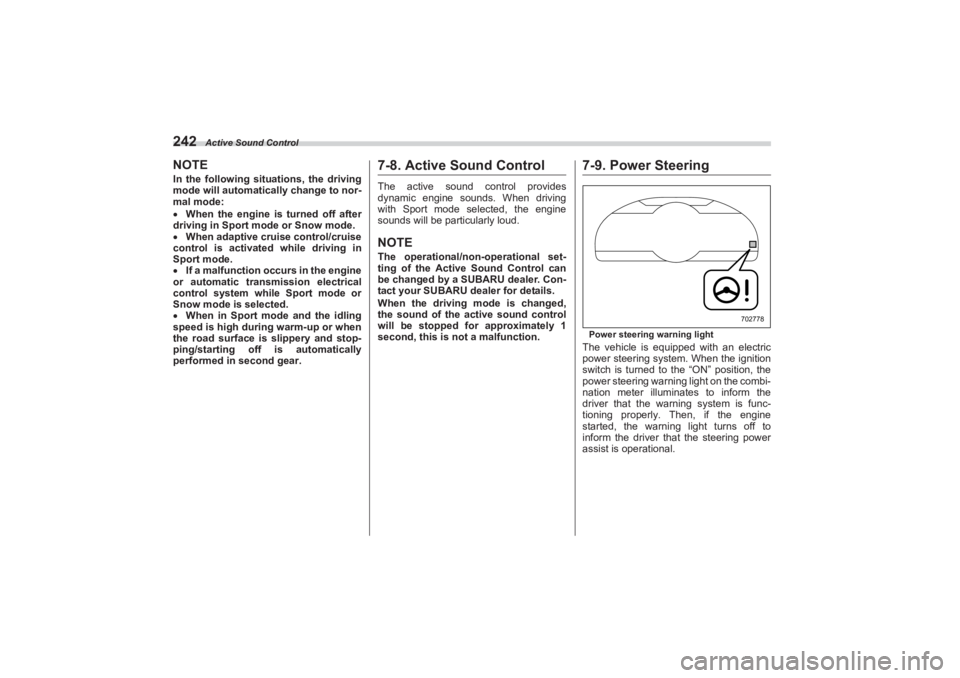
Active Sound Control
242NOTEIn the following situations, the driving
mode will automatically change to nor-
mal mode:
When the engine is turned off after
driving in Sport mode or Snow mode.
When adaptive cruise control/cruise
control is activated while driving in
Sport mode.
If a malfunction occurs in the engine
or automatic transmission electrical
control system while Sport mode or
Snow mode is selected.
When in Sport mode and the idling
speed is high during warm-up or when
the road surface is slippery and stop-
ping/starting off is automatically
performed in second gear.
7-8. Active Sound ControlThe active sound control provides
dynamic engine sounds. When driving
with Sport mode selected, the engine
sounds will be particularly loud.NOTEThe operational/non-operational set-
ting of the Active Sound Control can
be changed by a SUBARU dealer. Con-
tact your SUBARU dealer for details.
When the driving mode is changed,
the sound of the active sound control
will be stopped for approximately 1
second, this is not a malfunction.
7-9. Power SteeringPower steering warning lightThe vehicle is equipped with an electric
power steering system. When the ignition
switch is turned to the “ON” position, the
power steering warning light on the combi-
nation meter illuminates to inform the
driver that the warn ing system is func-
tioning properly. Then, if the engine
started, the warni ng light turns off to
inform the driver that the steering power
assist is operational.
702778
BRZ_U.book 242 ページ 2022年3月29日 火曜日 午後3時59分
Page 249 of 432
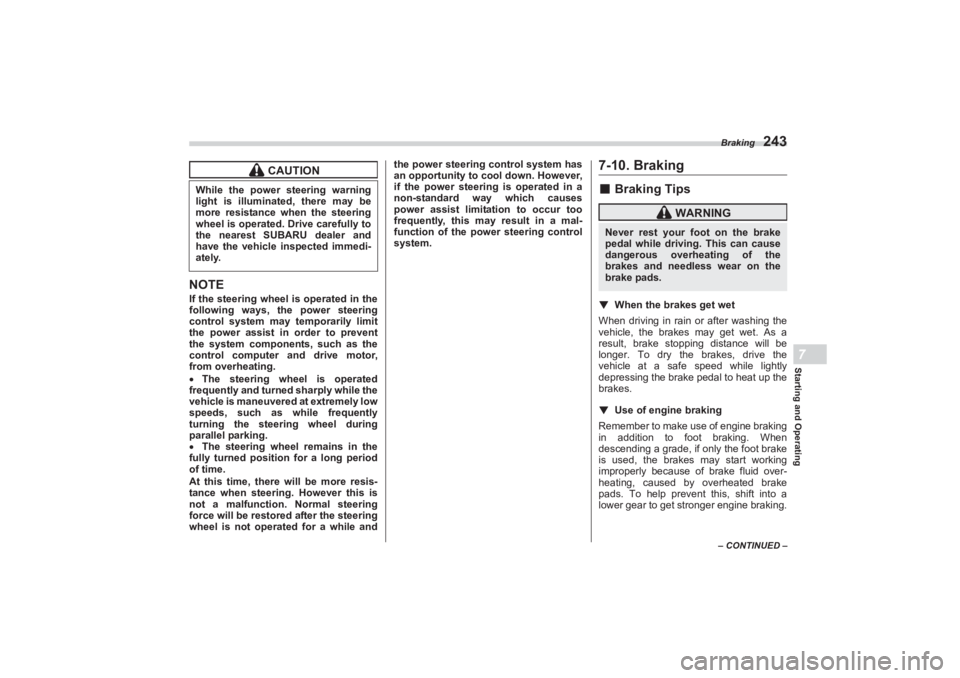
Braking
243
Starting and Operating7
– CONTINUED –
NOTEIf the steering wheel is operated in the
following ways, the power steering
control system may temporarily limit
the power assist in order to prevent
the system components, such as the
control computer and drive motor,
from overheating.
The steering wheel is operated
frequently and turned sharply while the
vehicle is maneuvered at extremely low
speeds, such as while frequently
turning the steering wheel during
parallel parking.
The steering wheel remains in the
fully turned position for a long period
of time.
At this time, there will be more resis-
tance when steering. However this is
not a malfunction. Normal steering
force will be restored after the steering
wheel is not operated for a while and the power steering control system has
an opportunity to cool down. However,
if the power steering is operated in a
non-standard way which causes
power assist limitation to occur too
frequently, this may result in a mal-
function of the power steering control
system.
7-10. Braking■ Braking Tips▼ When the brakes get wet
When driving in rain or after washing the
vehicle, the brakes may get wet. As a
result, brake stopping distance will be
longer. To dry the brakes, drive the
vehicle at a safe speed while lightly
depressing the brake pedal to heat up the
brakes.
▼ Use of engine brakingRemember to make use of engine braking
in addition to foot braking. When
descending a grade, if only the foot brake
is used, the brakes may start working
improperly because of brake fluid over-
heating, caused by overheated brake
pads. To help prevent this, shift into a
lower gear to get stronger engine braking.
CAUTION
While the power steering warning
light is illuminated, there may be
more resistance when the steering
wheel is operated. Drive carefully to
the nearest SUBARU dealer and
have the vehicle inspected immedi-
ately.
WARNING
Never rest your foot on the brake
pedal while driving. This can cause
dangerous overheating of the
brakes and needless wear on the
brake pads.
BRZ_U.book 243 ページ 2022年3月29日 火曜日 午後3時59分
Page 251 of 432
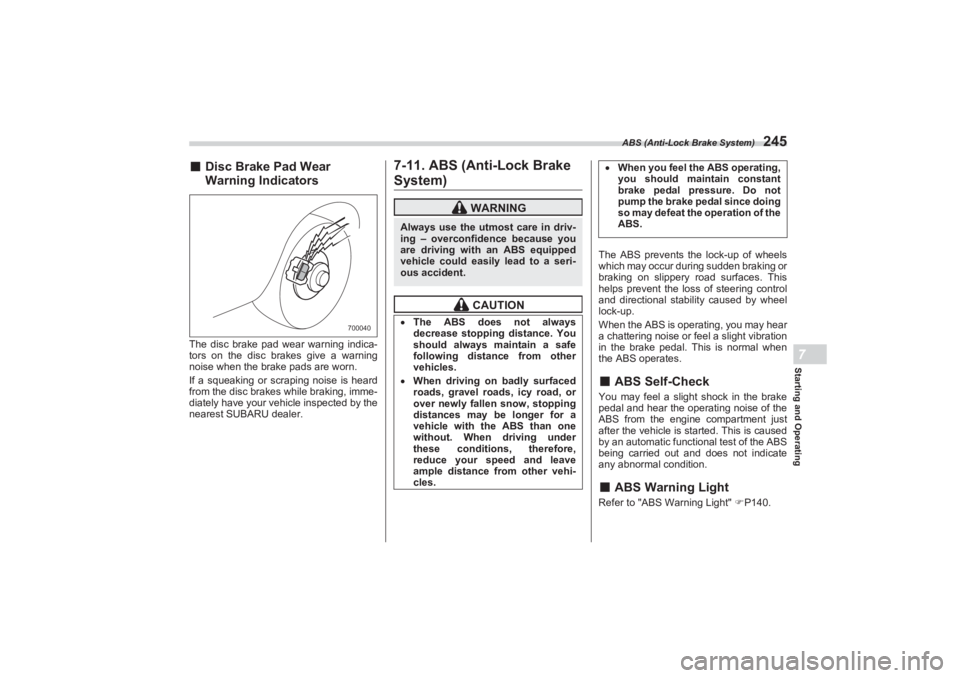
ABS (Anti-Lock Brake System)
245
Starting and Operating7
■Disc Brake Pad Wear
Wa rning IndicatorsThe disc brake pad wear warning indica-
tors on the disc brakes give a warning
noise when the brake pads are worn.
If a squeaking or scraping noise is heard
from the disc brakes while braking, imme-
diately have your vehicle inspected by the
nearest SUBARU dealer.
7-11. ABS (Anti-Lock BrakeSystem)
The ABS prevents the lock-up of wheels
which may occur during sudden braking or
braking on slippery road surfaces. This
helps prevent the loss of steering control
and directional stability caused by wheel
lock-up.
When the ABS is operating, you may hear
a chattering noise or f eel a slight vibration
in the brake pedal. This is normal when
the ABS operates.■ ABS Self-CheckYou may feel a slight shock in the brake
pedal and hear the operating noise of the
ABS from the engine compartment just
after the vehicle is started. This is caused
by an automatic functional test of the ABS
being carried out and does not indicate
any abnormal condition.■ ABS Warning LightRefer to "ABS Warning Light" P140.
700040
WARNING
Always use the utmost care in driv-
ing – overconfidence because you
are driving with an ABS equipped
vehicle could easily lead to a seri-
ous accident.
CAUTION
The ABS does not always
decrease stopping distance. You
should always maintain a safe
following distance from other
vehicles. When driving on badly surfaced
roads, gravel roads, icy road, or
over newly fallen snow, stopping
distances may be longer for a
vehicle with the ABS than one
without. When driving under
these conditions, therefore,
reduce your speed and leave
ample distance from other vehi-
cles.
When you feel the ABS operating,
you should maintain constant
brake pedal pressure. Do not
pump the brake pedal since doing
so may defeat the operation of the
ABS.
BRZ_U.book 245 ページ 2022年3月29日 火曜日 午後3時59分
Page 255 of 432
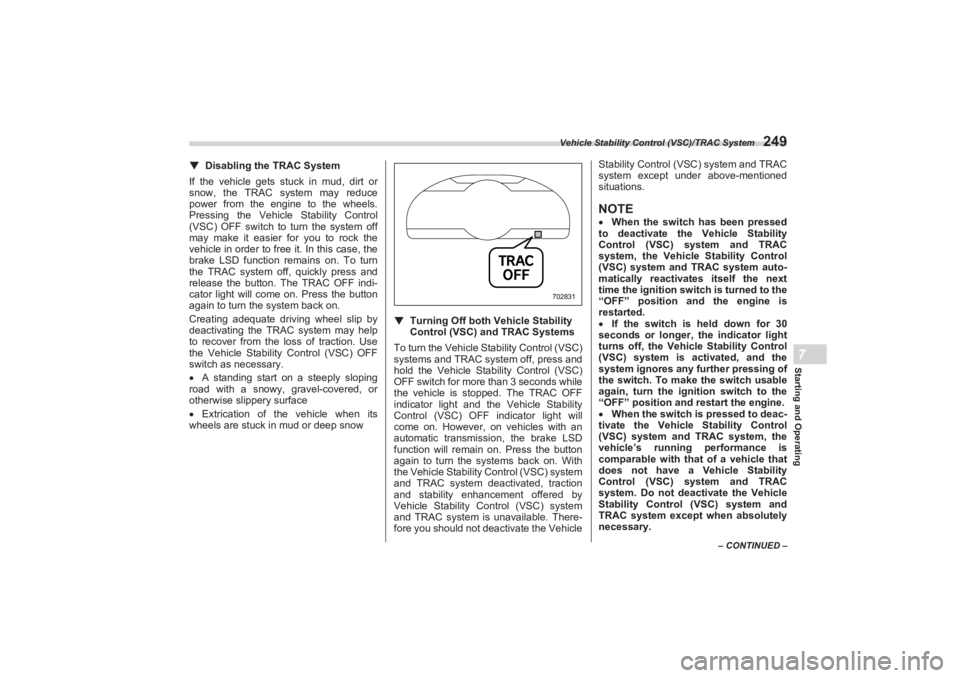
Vehicle Stability Control (VSC)/TRAC System
249
Starting and Operating7
– CONTINUED –
▼Disabling the TRAC System
If the vehicle gets stuck in mud, dirt or
snow, the TRAC system may reduce
power from the engine to the wheels.
Pressing the Vehicle Stability Control
(VSC) OFF switch to turn the system off
may make it easier for you to rock the
vehicle in order to free it. In this case, the
brake LSD function remains on. To turn
the TRAC system off, quickly press and
release the button. The TRAC OFF indi-
cator light will come on. Press the button
again to turn the system back on.
Creating adequate driving wheel slip by
deactivating the TRAC system may help
to recover from the loss of traction. Use
the Vehicle Stability Control (VSC) OFF
switch as necessary.
A standing start on a steeply sloping
road with a snowy, gravel-covered, or
otherwise slippery surface
Extrication of the vehicle when its
wheels are stuck in mud or deep snow ▼
Turning Off both Vehicle Stability
Control (VSC) and TRAC Systems
To turn the Vehicle Stability Control (VSC)
systems and TRAC system off, press and
hold the Vehicle Stability Control (VSC)
OFF switch for more than 3 seconds while
the vehicle is stopped. The TRAC OFF
indicator light and the Vehicle Stability
Control (VSC) OFF indicator light will
come on. However, on vehicles with an
automatic transmissi on, the brake LSD
function will remain on. Press the button
again to turn the systems back on. With
the Vehicle Stability Control (VSC) system
and TRAC system deactivated, traction
and stability enhancement offered by
Vehicle Stability Control (VSC) system
and TRAC system is unavailable. There-
fore you should not deactivate the Vehicle Stability Control (VSC) system and TRAC
system except under above-mentioned
situations.
NOTE When the switch has been pressed
to deactivate the Vehicle Stability
Control (VSC) system and TRAC
system, the Vehicle Stability Control
(VSC) system and TRAC system auto-
matically reactivates itself the next
time the ignition swit ch is turned to the
“OFF” position and the engine is
restarted.
If the switch is held down for 30
seconds or longer, the indicator light
turns off, the Vehicle Stability Control
(VSC) system is activated, and the
system ignores any further pressing of
the switch. To make the switch usable
again, turn the ignition switch to the
“OFF” position and restart the engine.
When the switch is pressed to deac-
tivate the Vehicle Stability Control
(VSC) system and TRAC system, the
vehicle’s running performance is
comparable with that of a vehicle that
does not have a Vehicle Stability
Control (VSC) system and TRAC
system. Do not deac tivate the Vehicle
Stability Control (VSC) system and
TRAC system except when absolutely
necessary.
702831
BRZ_U.book 249 ページ 2022年3月29日 火曜日 午後3時59分
Page 261 of 432

Parking Your Vehicle
255
Starting and Operating7
– CONTINUED –
■When Initialization of the Tire
Pressure Monitoring System
has FailedInitialization can be completed in a few
minutes. However, in the following case,
the settings have not been recorded and
the system will not o perate properly. If
repeated attempts to record tire inflation
pressure settings ar e unsuccessful, have
the vehicle checked at your SUBARU
dealer.
When operating the TPMS set switch,
low tire pressure warning light does not
blink 3 times.
After carrying out the initialization
procedure, the low tire pressure warning
light blinks for 1 minute then stays on after
driving for 20 minutes.
■ Registering ID CodesEvery tire pressure warning valve and
transmitter has a unique ID code. In addi-
tion to the set of tire pressure monitoring
system sensor ID code s initially registered
to the vehicle, a second set of ID codes
can be registered.
A second set of tire pressure monitoring
system sensor ID codes can be registered
at your SUBARU dealer. When 2 sets of
ID codes have been registered, either ID
code set can be selected.■ Changing the ID code set1. Park the vehicle in a safe place and
turn the ignition swit ch to the “ON” posi-
tion.
2. Press the TPMS set switch 3 times
within 3 seconds.
3. The low tire pressure warning light will
illuminate for 3 seconds and then blink 3
times.
4. The low tire pressure warning light will
blink for 1 minute and then illuminate.
5. When the ID code change has
completed, the tire pressure monitoring
light will turn off.
Check that tire pressures are displayed on
the TPMS screen.
7-16. Parking Your Vehicle■ Parking BrakeTo set the parking brake, depress the
brake pedal firmly and hold it down until
the parking brake lever is fully pulled up.
WARNING
Do not operate the TPMS set switch
without first adjust ing the tire infla-
tion pressure to the specified level.
Otherwise, the low tire pressure
warning light may not come on even
if the tire inflation pressure is low,
or it may come on when the tire
inflation pressure is actually nor-
mal.
WARNING
Never leave unattended children
or pets in the vehicle. They could
accidentally injure themselves or
others through inadvertent oper-
ation of the vehicle. Also, on hot
or sunny days, the temperature in
a closed vehicle could quickly
become high enough to cause
severe or possibly fatal injuries to
people. Do not park the vehicle over flam-
mable materials such as dry
grass, waste paper or rags, as
they may burn easily if they come
near hot engine or exhaust
system parts. Be sure to stop the engine if you
take a nap in the vehicle. If engine
exhaust gas enters the passenger
compartment, occupants in the
vehicle could die from carbon
monoxide (CO) contained in the
exhaust gas.
BRZ_U.book 255 ページ 2022年3月29日 火曜日 午後3時59分
Page 263 of 432

Hill Start Assist System
257
Starting and Operating7
– CONTINUED –
7-17. Hill Start Assist SystemThe Hill start assist system is a device to
make the following vehicle operations
easier.
1) Starting forward facing uphill
2) Starting backward facing downhill
A) Brake pedal (both MT models and AT
models)
B) Clutch pedal (MT models only)
In both these cases, the Hill start assist
system operates under the following
conditions.
The clutch pedal is depressed while the
brake pedal is also depressed (MT
models).
The vehicle has stopped with the brake
pedal depressed (AT models).
Braking power is maintained temporarily
(for approximately 2 seconds) by the Hill
start assist system after the brake pedal is
released. The driver is therefore able to
start the vehicle in the same way as on a
level grade, just using the clutch pedal
(MT models only) and accelerator pedal
(all models).
If the braking power of the Hill start assist
system is insufficient after the brake pedal
is released, apply more braking power by
depressing the brake pedal again.
The Hill start assist system may not
operate on slight grades. Also, the Hill
start assist system does not operate in the
following cases.
WARNING
The Hill start assist system is a
device only for helping the driver
to START the vehicle on an uphill
grade. To prevent accidents when
the vehicle is parked on a slope,
be sure to firmly set the parking
brake. When setting the parking
brake, make sure that the vehicle
remains stationary when the
clutch pedal (MT models) and
brake pedal (both MT and AT
models) are released. Do not turn the ig nition switch to
the “OFF” position while the Hill
start assist system is operating.
The Hill start assist system will be
deactivated and may lead to an
accident.
1
2 BA
7 0 111 6
BRZ_U.book 257 ページ 2022年3月29日 火曜日 午後3時59分